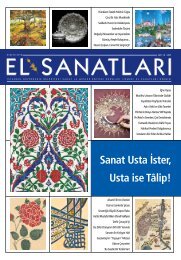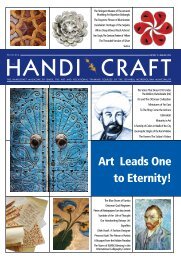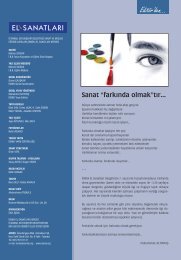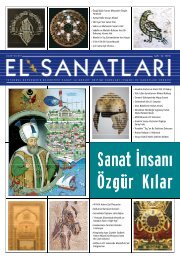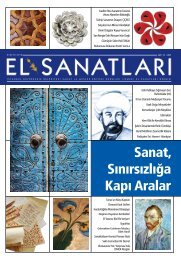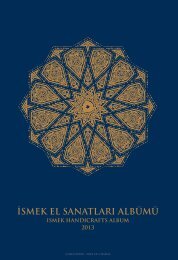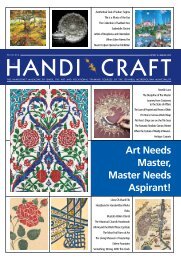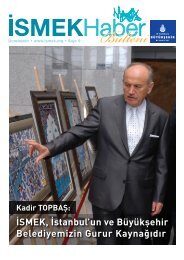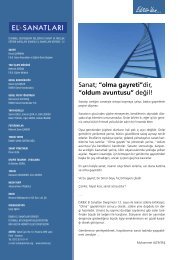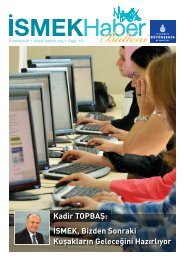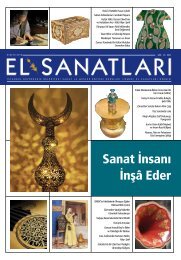Download Link - Ä°SMEK
Download Link - Ä°SMEK
Download Link - Ä°SMEK
Create successful ePaper yourself
Turn your PDF publications into a flip-book with our unique Google optimized e-Paper software.
ISTANBUL ISLAM SCIENCE<br />
AND TECNOLOGY MUSEUM<br />
M.Fatih SERENLI*, Detlev QUINTERN**<br />
Istanbul Islam Science and Tecnology Museum which was<br />
opened to visitors in the Spring of 2008 in Gulhane Park, functions<br />
in the restorated buildings which were used as the Royal<br />
Stables of the Ottoman Palace. Metal rings and angles used<br />
for lariating the sultan’s horses are still conserved on the old<br />
internal walls of the museum. The Future and the past melt in<br />
each other where the charm of the old building connects with<br />
the museum that houses the state-of-the-art communication<br />
technology.<br />
Caliph Memun’s Sphere<br />
In The Ottoman Rose Garden<br />
The ones who spent their chilhood years in Istanbul<br />
during the 80’s and early 90’s will very well<br />
know that the Gulhane Park in the past was a<br />
place where festive events and open-air concerts<br />
were held and where the one and only zoo of<br />
the city was located. In time, the park, once used<br />
to be the royal garden of the Ottoman times<br />
and became famous of its rose gardens which<br />
it was named after had been neglected and untended.<br />
But currently there is nothing apparent<br />
to remind the uncaredfor situation of the recent<br />
past. We can even comment that the Park today<br />
has become one of the largest and wellkept<br />
green zones in the European part of the<br />
city. We are proceeding in the park along with<br />
the rustling sound of the autumn leaves that are<br />
about to fall from the gigantic trees challenging<br />
The museum established on a 3500 square meters area, houses<br />
architectural works of art and machines and other artifacts belonging<br />
to the fields of astronomy, medicine, mineralogy, physics,<br />
chemistry, optics, clock-making and war technology, that<br />
were built between the 8th and 16th centuries A.D., which<br />
represents the apex of science and technology in the Islamic<br />
civilization. Within the context it can also observed how the scientific<br />
know-how and technology passed on to the West from<br />
the Islamic civilizations by means of exhibition of the redesigned<br />
versions of old devices, tools and samples.<br />
Uniting the thirst for knowledge and love and acumen with the<br />
desire to reach to the divinal secret of the mathematical order in<br />
the nature and the universe have been the main drivers behind<br />
the rise of the young islamic scientists in the 7th century. With<br />
the everthriving observation and measurement methods, they<br />
developed proper tools and devices and weighing scales. This<br />
perfectionism that was incepted in the 9th century was not a<br />
movement to kickstart a new scientific understanding, but a<br />
sacred effort to use science for the good of mankind.<br />
In the eurocentric history of science, Renaissance is deemed as<br />
the revitalization of antiquity. The medieval age, which lasted<br />
for a 1000 years in between the antic ages and the Renaissance<br />
was accepted as the “dark ages” for Europe. Depicted within<br />
the permanence of the history of science, it’s been argued that<br />
islamic science was born and matured in between the 8th and<br />
16th centuries. Even considered in most good faith, the scientific<br />
works and accomplishments of the islamic civlization in<br />
various fields have mostly been disregarded together with the<br />
fact that throughout these 8 centuries the only language that<br />
the Greek and Roman classics of the antiquity had been trans-<br />
44



